Collection of materials relating to neuro-ophthalmology as part of the Neuro-Ophthalmology Virtual Education Library.
NOVEL: https://novel.utah.edu/
TO
- NOVEL195
Filters: Collection: "ehsl_novel_novel"
| Title | Creator | Description | Subject | ||
|---|---|---|---|---|---|
| 101 |
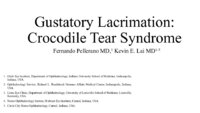 |
Gustatory Lacrimation: Crocodile Tear Syndrome | Fernando Pellerano; Kevin Lai | We describe a case of gustatory lacrimation on a 61-year-old male with a history of Bell's Palsy that presented to the Ophthalmology clinic with painless epiphora in the right eye while eating. Examination was notable for oral-ocular synkinesis and hyperlacrimation while eating on the right eye only... | Crocodile Tear Syndrome; Gustatory Lacrimation; Oral-ocular Synkinesis |
| 102 |
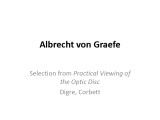 |
Albrecht von Graefe | Kathleen B. Digre, MD; James J. Corbett, MD | Biography of Albrecht von Graefe. | Albrecht von Graefe; History |
| 103 |
 |
Chiasmal Neuritis in Multiple Sclerosis | Kathleen B. Digre, MD; James J. Corbett, MD | Slideshow describing condition. | Multiple Sclerosis |
| 104 |
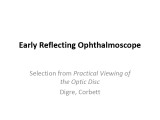 |
Early Reflecting Ophthalmoscope | Kathleen B. Digre, MD; James J. Corbett, MD | The use of the early reflecting ophthalmoscope. | Reflecting Ophthalmoscope; History |
| 105 |
 |
Jean Martin Charcot | Kathleen B. Digre, MD; James J. Corbett, MD | Biography of Jean Martin Charcot | Jean Martin Charcot; History |
| 106 |
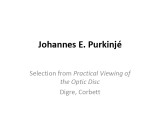 |
Johannes E. Purkinjé | Kathleen B. Digre, MD; James J. Corbett, MD | Biography of Johannes E. Purkinjé. | Johannes E. Purkinjé; History |
| 107 |
 |
The May Ophthalmoscope | Kathleen B. Digre, MD; James J. Corbett, MD | History of the ophthalmoscope developed by Charles May | Ophthalmosocope; History |
| 108 |
 |
Retinitis Pigmentosa | Gregory P. Van Stavern, MD | Retinitis pigmentosa is a retinal/choroidal degeneration caused by various genetic defects. The term retinitis pigmentosa is really a misnomer since it is not inflammation (retinitis) and it is not a disease of the pigmentary system (pigmentosa). | Retinitis Pigmentosa |
| 109 |
 |
Retinitis Pigmentosa - Rod Dystrophy | Gregory P. Van Stavern, MD | PowerPoint discussing retinitis pigmentosa, rod dystrophy. Retinitis Pigmentosa is a generalized retinal dystrophy with peripheral rather than central onset Primarily rod-cone dystrophy. Provides images. | Rod Dystrophy; Rod Dystrophy; Retinitis Pigmentosa; Night Dlindness |
| 110 |
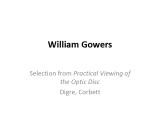 |
William Gowers | Kathleen B. Digre, MD; James J. Corbett, MD | Biography of William Gowers. | William Gowers; History; Biography |
| 111 |
 |
The Clinical Examination of Higher Order Visual Function: Syndrome-based Approach - Visual Simultanagnosia | Victoria S. Pelak, MD; James R. Bateman, MD, MPH; Brianne Bettcher, PhD | Explanation of higher order visual function examination. | Visual Function; Visual Simultanagnosia |
| 112 |
 |
Best's Vittelform Maculopathy | Gregory P. Van Stavern, MD | This 14 year old presented with decreased vision, headaches and central scotomas. She was found to have bilateral papilledema related to IIH and also Best's vitilliform maculopathy. The maculas are commonly described as having a "fried egg" sunny side up appearance. | Best Macular Dystrophy |
| 113 |
 |
Cone Dystrophy | Gregory P. Van Stavern, MD | PowerPoint discussing Cone Dystrophy: Early loss of central and color vision; Color impairment often out of proportion to loss of VA; Hemeralopia ("day blindness") prominent; Light sensitivity and photophobia; Macular changes variable, and may occur late- may "Bull's Eye" pattern; Abnormal Photost... | Cone Dystrophy; Occult Macular Dystrophy; Central Cone Dystrophy |
| 114 |
 |
Cranial Nerves: Neuroanatomy Video Lab - Brain Dissections | Suzanne S. Stensaas, PhD | The approach is to learn to associate the cranial nerves with their brainstem level and blood supply. Emphasis is given to the midbrain (3, 4), pons (5, 6, 7, 8), medulla (9, 10, 11, 12) and their most important functions. | Cranial Nerves; Brain; Dissection |
| 115 |
 |
Hermann Ludwig Ferdinand von Helmholtz | Kathleen B. Digre, MD; James J. Corbett, MD | Biography of Hermann Ludwig Ferdinand von Helmholtz. | Hermann Ludwig Ferdinand von Helmholtz; History |
| 116 |
 |
NANOS Illustrated Curriculum Section H Introduction | Sean Gratton, MD; Zoë R. Williams, MD | Introduction video to the resources available in Section H of the NANOS Illustrated Curriculum. | History, Neuro-ophthalmology; Principles of Practice, Neuro-Ophthalmology; Systems of Healthcare; Research, Neuro-ophthalmology |
| 117 |
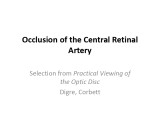 |
Occlusion of the Central Retinal Artery | Kathleen B. Digre, MD; James J. Corbett, MD | Slideshow describing occlusion of the central retinal artery. | Occlusion; Retinal Artery |
| 118 |
 |
Papilledema 2013 | Kathleen B. Digre, MD | Objectives: What types of disc findings can be confused for papilledema List the features of true disc swelling Describe the tests you would order to evaluate and w/u papilledema List differential diagnosis of papilledema Describe possible treatments for papilledema (medical and surgical) | Papilledema |
| 119 |
 |
Photophobia for Patients | Kathleen B. Digre, MD | The symptoms of light sensitivity are: an uncomfortable sense of brightness, squinting, frequent blinking, and redness of the eye (especially if the eye is dry). Involuntary eye closure and excessive blinking is seen with blepharospasm. Individuals will tend to seclude themselves in darkness. | Photophobia |
| 120 |
 |
Photophobia for Patients - Large Print | Kathleen B. Digre, MD | The symptoms of light sensitivity are: an uncomfortable sense of brightness, squinting, frequent blinking, and redness of the eye (especially if the eye is dry). Involuntary eye closure and excessive blinking is seen with blepharospasm. Individuals will tend to seclude themselves in darkness. | Photophobia |
| 121 |
 |
Venous Drainage of the Eye | Kathleen B. Digre, MD; James J. Corbett, MD | Slideshow describing condition. | Eye Anatomy; Venous Anatomy |
| 122 |
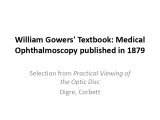 |
William Gowers' Textbook | Kathleen B. Digre, MD; James J. Corbett, MD | Presentation on William Gowers' contribution to neuro ophthalmology. | William Gowers; History of Neuro-ophthalmology |
| 123 |
 |
A Brief Introduction to AI in Neuro-ophthalmology | Areeba Abid, BS; Sachin Kedar, MD | In this video, we describe the basics of artificial intelligence and machine learning as applicable to clinical neuro-ophthalmologists. We use the example from a recent publication, where AI software was used to detect optic disc edema in fundus images. | Artificial Intelligence; Machine Learning |
| 124 |
 |
Aberrant Regeneration Third Nerve | Gregory P. Van Stavern, MD | 48 year old woman S/P rupture and repair of right sided posterior communicating artery aneurysm Video shows residual partial right third nerve palsy, with aberrant regeneration, causing a pseudo Von Graefe's sign (elevation of the right upper eyelid with attempted infraduction of the right eye) | Aberrant Regeneration Third Nerve; Third Nerve Palsy |
| 125 |
 |
Brain MRI in Multiple Sclerosis | Anne G. Osborn, MD | Slideshow describing condition. | Abducting Nystagmus; Bilateral Internuclear Ophthalmoplegia; Botulinum Toxin Therapy; Gaze Evoked Downbeat Nystagmus; Horizontal Pendular Nystagmus; Horizontal Saccadic Dysmetria; Lid Nystagmus; Multiple Sclerosis; Normal Convergence; Oscillopsia; Pendular Horizontal Oscillations; Saccadic Dysmetri... |
